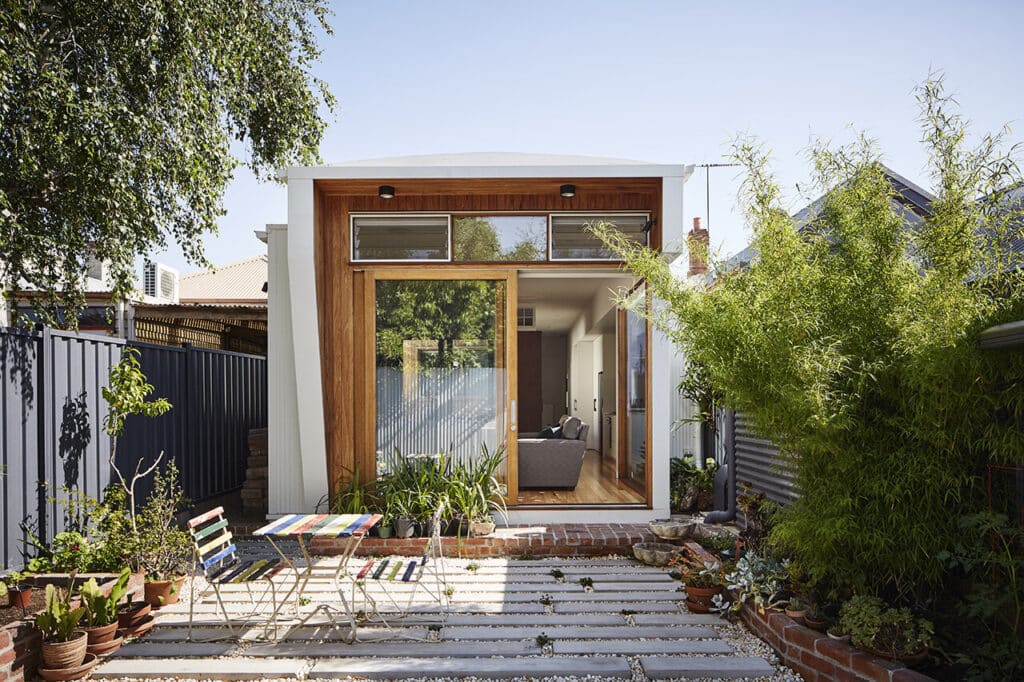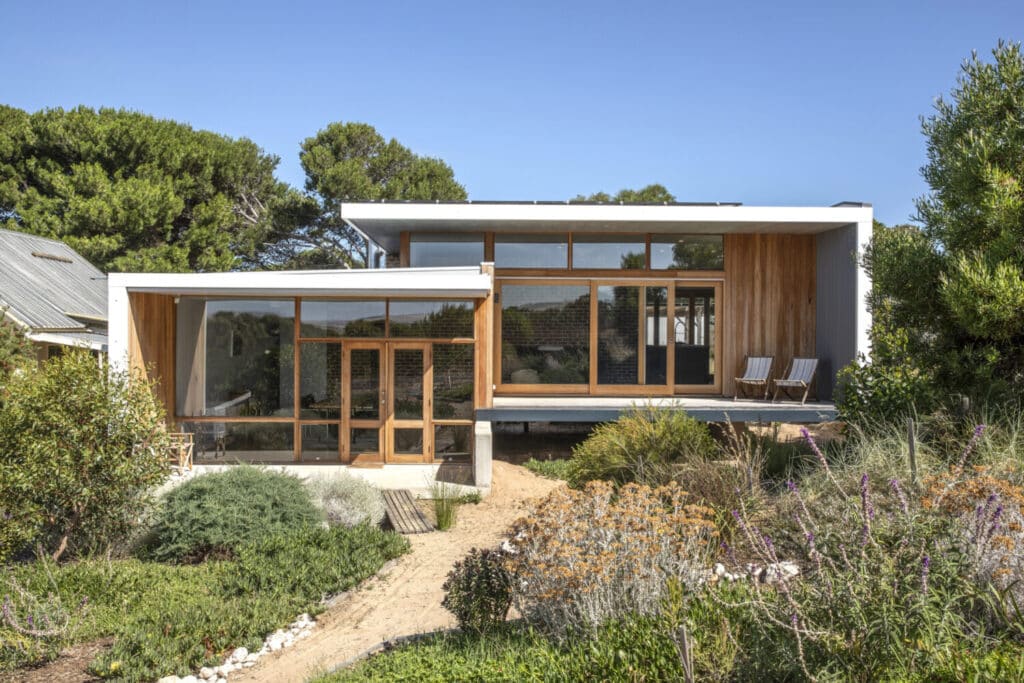Contents:
- What is Sustainable Design?
- Why is Sustainable Design Important?
- The Origins of Sustainable Design
- 5 Sustainable Design Trends
- FAQs
In our modern world, sustainability is becoming more and more prevalent as the need for it grows. From conserving resources to reducing carbon footprint, individuals and businesses alike are trying to do their part to minimize their negative impact on the environment.
~The TNFD is the first sustainability reporting framework specifically designed for biodiversity and nature-related issues. Download our white paper to learn how it’s prompting businesses to take decisive action~
Real estate accounts for approximately 39 percent of total global emissions. Around 11 percent of these emissions are generated by the manufacturing materials used in buildings, while the rest is emitted from buildings themselves and by generating the energy that powers them.
In a study by the Bank of England, high carbon emitting properties decreased in value after climate policies were enacted (these policies include raising carbon prices, building and energy efficiency standards, and subsidies for renewable energy). It’s not only better for the environment; sustainable design can improve the bottom line for real estate companies and property managers.
What is Sustainable Design?

Sustainable design is a holistic approach to architecture and interior design that utilizes materials and construction methods that lessen the impact on the environment – both during the construction process and once the building has been completed and is in use. This design philosophy prioritizes the planet and its resources by implementing innovative strategies and techniques that significantly reduce energy consumption and waste production.
Sustainable design thinks outside the box to find creative alternatives to standard building practices and materials. Minimizing negative impact is the baseline; positively contributing to the preservation of a healthy planet is the goal.
Why is Sustainable Design Important?

Buildings account for about 40 percent of our nation’s energy use and consume 75 percent of our nation’s electricity. The building sector, including buildings operations and construction emissions, accounts for more than one third of global energy-related greenhouse gas emissions, and with increasing urbanization and housing needs, that percentage could substantially increase over the years ahead without additional intervention.
Additionally, according to the World Economic Forum, humans are currently using the equivalent of 1.75 Earths to maintain our current way of life; the ecosystems of our planet cannot keep up with our demands. Sustainable design contributes to the conservation of natural resources and the reduction of the usage of non-renewable resources.
Sustainable design implements eco-friendly materials and construction methods, which serves to minimize the overall impact of a structure on the environment. By promoting the use of sustainable materials that are non-toxic and biodegradable, sustainable design minimizes pollution and prevents further damage to the environment.
It’s also not just about environmental health, but the health and well-being of the occupants of the built environment – us. By avoiding the use of construction materials containing volatile organic compounds and other harmful chemicals, sustainable design mitigates health risks to residents of buildings and infrastructure projects.
The Origins of Sustainable Design

THE SEEDS OF THE MODERN ENVIRONMENTAL MOVEMENT
Rachel Carson’s Silent Spring (1962) alarmed readers across America and led to a new public awareness that human actions were responsible for altering the planet. Carson changed the conversation about the environment by emphasizing how humanity is an interconnected part of nature, not separate and above it.
Carson’s sensational bestseller helped transform and broaden the older, less accessible conservation movement into more comprehensive and ecologically informed environmentalism. It wasn’t just conservationists, ecologists, and biologists anymore – more and more people started to advocate for the protection of the planet.
Then, amid this national environmental awakening, Ian McHarg published his book, Design with Nature, in 1969. He expanded on Carson’s central ideas, arguing that the way we occupy and modify the earth is best when it is planned and designed with careful regard to both the ecology and the character of the landscape.
Design with Nature and Silent Spring helped to instigate a series of political victories that would come to define the ‘70s as the ‘environmental decade’ – the National Environmental Policy Act (1970), the Clean Water Act (1972), the Endangered Species Act (1973), and the creation of the Environmental Protection Agency (EPA).
THE PARTISAN AND POLARIZING RESPONSE TO THE ENVIRONMENTAL MOVEMENT
The general ideas behind sustainable design started gaining traction during this decade, but would hit roadblocks as American politics grew increasingly fractured. Silent Spring gave a warning about the dangers of unimpeded technological progress and unregulated industry. Critics saw this as unfavorable to US economic interests – and because this was in the middle of the Cold War, any criticism of capitalism was taken as un-American at best and communist at worst.
The Reagan administration initially embraced deregulation as an overarching goal; Reagan appointed Anne M. Burford, an aggressive champion of industry, as the Administrator of the EPA. She moved to slash budgets, reduce environmental enforcement, and open public lands and resources for mining, drilling, grazing, and other private profit-making activities.
However, in 1983, Burford was forced to resign amid Congressional investigations into mismanagement in cleaning up toxic waste. Her successors, William D. Ruckelshaus and Lee M. Thomas, worked to return the EPA to a moderate course.
THE FORMALIZATION OF THE GREEN BUILDING MOVEMENT AND SUSTAINABLE DESIGN

After the failure of Reagan’s environmental command-and-control strategy, George H. W. Bush introduced the idea that the market and the environment were not, in fact, opposing goals, but rather could be interlinked. He provided economic incentives for companies to reduce their carbon and pollution emissions.
In 1990, the American Institute of Architects Committee on the Environment (COTE) was formed; it is now the oldest organization in the US dedicated to sustainable design. One of its founders, Bob Berkebile, described the need for “sustainable architecture” – a phrase so unfamiliar that, according to Google Scholar, it appeared in print only four times that year—all in obscure academic papers.
As architecture and design publication Metropolis puts it, “COTE initiated what sociologists refer to as the third of four phases of any social movement, “formalization”—the point at which nascent ideas become organized in ways that help it grow dramatically in scale.” (With its September 2996 issue, Metropolis was actually among the first design magazines anywhere to highlight sustainability.)
The accomplishments of the Bush administration on behalf of the environment paved the way for the Clinton administration to adopt a “Greening of the White House” program that proved to be very successful. In 1993, the US Green Building Council (USGBC) was formed to promote the design and construction of buildings that are environmentally responsible, profitable, and healthy places to live and work.
Eight years after the formation of the USGBC, they unveiled the first pilot program of the Leadership in Energy and Environmental Design (LEED) rating system: a framework for healthy, efficient, and cost-saving green buildings, which offer environmental, social, and governance benefits. By 2003, LEED was refined to its current form used worldwide.
Since the ‘90s and 2000s, agencies and countries around the world have adopted their own green building programs and standards. The concept of sustainable design has evolved into a necessary cornerstone in the architecture sector and a major focus of the building industry in seeking to address climate and environment issues.
5 Sustainable Design Trends
TREND #1: ENERGY EFFICIENCY
Architects employing sustainable design practices will use passive and active strategies to reduce the energy consumption of a building, minimizing its carbon footprint.
Passive strategies include taking advantage of a site’s natural environmental factors, like the orientation of the sun and climate conditions, when placing a building and deciding where windows will be located to optimize for natural lighting, heating, and ventilation. Properly orienting a building to maximize natural daylight and minimize heat gain or loss can reduce the need for artificial lighting and heating or cooling.
Active strategies employ highly efficient HVAC, electrical, plumbing and other systems. These energy-saving technologies are designed to operate more efficiently, reducing the amount of electricity needed to power them – not only does this reduce the carbon footprint, but also cuts down the cost of utility bills.
TREND #2: BIOPHILIC DESIGN
Biophilic design incorporates natural elements, such as plants and natural materials, into the built environment to satisfy human’s innate need to connect with nature. Many of these principles overlap with sustainable design.
For example, bringing living greenery indoors is a biophilic design principle, falling under the “Nature in the Space” pillar. This dimension of biophilic design addresses the direct, physical, and ephemeral presence of nature in a space.
A sustainably designed building prioritizes its indoor air quality to promote the health and comfort of those who will live or work in it. Important design elements include well-designed ventilation, moisture control, and fresh air exchanges – plants also improve indoor air quality by raising oxygen levels and actively purifying the air.
TREND #3: WATER MANAGEMENT SYSTEMS
Sustainable design also takes into consideration how buildings can conserve and manage their water resources efficiently. Designers can take advantage of water-saving, low-flow plumbing appliances (faucets, showerheads, toilets, etc), to significantly reduce water consumption in a building.
Additionally, incorporating rainwater harvesting and using native or drought-tolerant plants for landscaping reduces water consumption and minimizes the strain on local water resources. Proper stormwater management techniques, such as permeable pavement, green roofs, and rain gardens, can also help prevent water pollution and minimize runoff.
TREND #4: RESPONSIBLE MATERIAL SOURCING
The materials used in a building can play a significant role in its environmental impact and carbon footprint. Standard building materials, such as cement, concrete, and steel, produce copious amounts of carbon emissions during their production processes. Opting for locally sourced, recycled, or reclaimed materials helps reduce the carbon footprint associated with the transportation, extraction, and refinement of raw materials.
Additionally, using materials with low embodied energy, such as wood or bamboo, can further minimize the environmental impact of a building. Embodied energy is the amount of energy consumed by all the processes associated with the acquisition of a building material, including mining, processing, manufacturing, transportation, and delivery of the final material.
Choosing materials that are certified by third-party organizations for their sustainability, such as Forest Stewardship Council (FSC) certified wood or Cradle to Cradle (C2C) certified products, can also ensure that the materials used in the building are environmentally responsible.
TREND #5: NON-TOXIC MATERIALS
When creating a space with sustainable design in mind, the quality and safety of materials needs to be considered. Many conventional furniture products are treated with toxic substances such as formaldehyde, flame retardants, and volatile organic compounds (VOCs). VOCs can also be found in paint, carpeting, and adhesives.
These substances pose health risks by degrading indoor air quality; they also have a negative impact on the environment. When products and materials containing VOCs are discarded and introduced into the environment, the VOCs react with nitrogen oxides emitted from vehicles and industrial activities to form ozone. This contributes to global warming.
Other synthetic materials, such as polyester and nylon, shed microplastics that not only end up in our oceans, but in our bodies. Polyester sheds more microplastics than any other material, making up nearly three-quarters of microplastic pollution in the Arctic and two-thirds of the microplastics in household dust.
Opting for high-quality, low-VOC, nontoxic products that are designed to last is a key part of sustainable design — it reduces waste, minimizes negative environmental impact, and prioritizes human health and well-being.
FAQs
Q: What is sustainable design?
A: Sustainable design is a holistic approach to architecture and interior design that utilizes materials and construction methods that lessen the impact on the environment — both during the construction process and once the building has been completed and is in use.
Q: What is one way to incorporate sustainable design?
A: Utilize energy efficient systems to heat and cool your home.
Q: When was the US Green Building Council formed?
A: 1993







